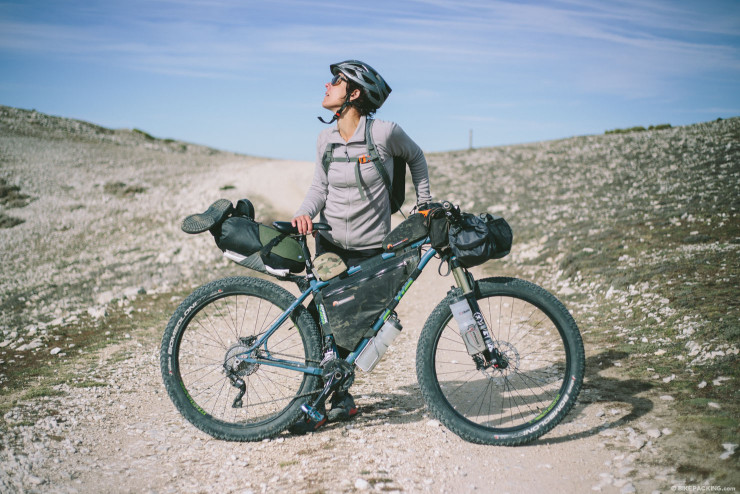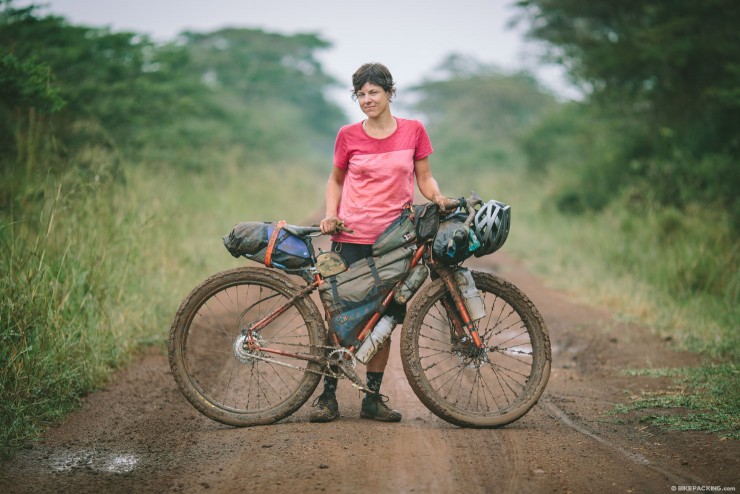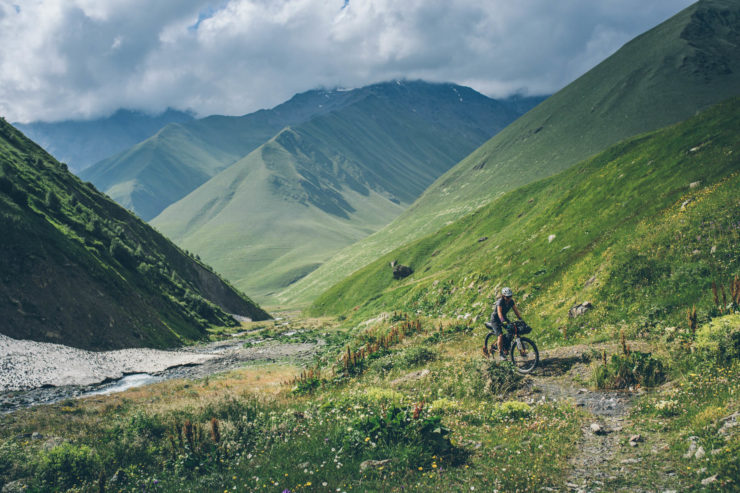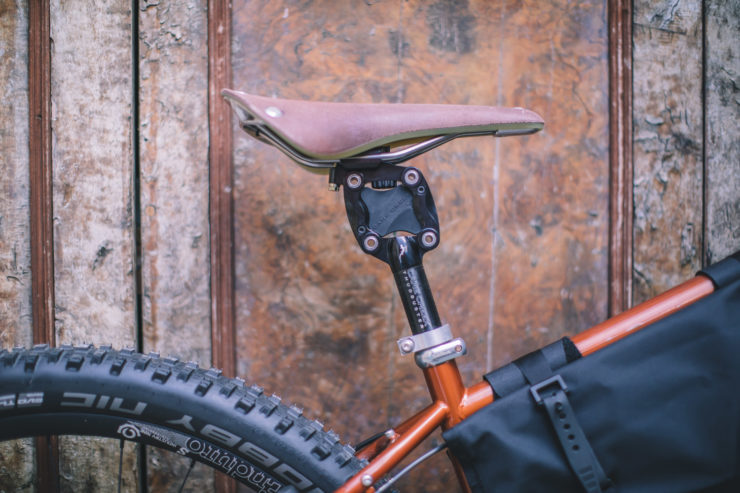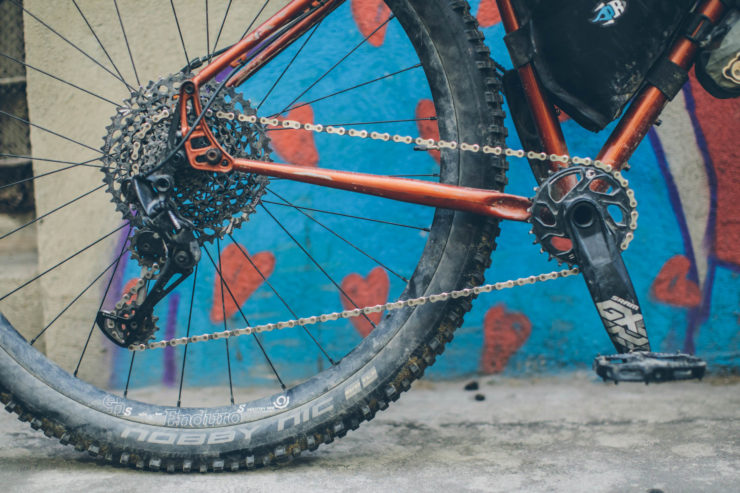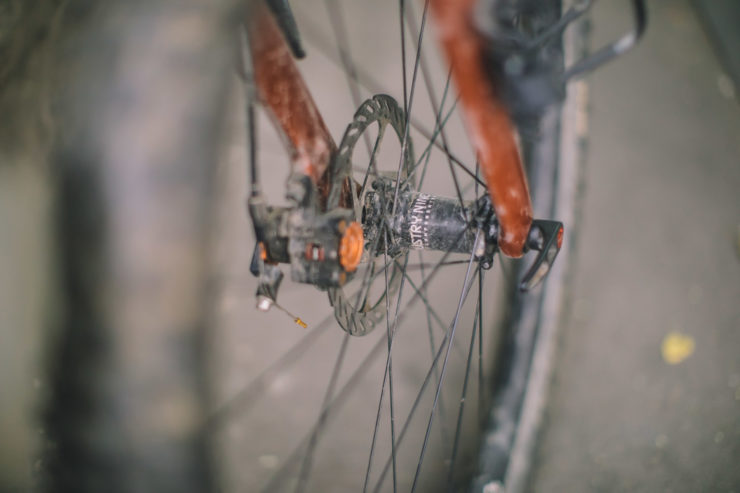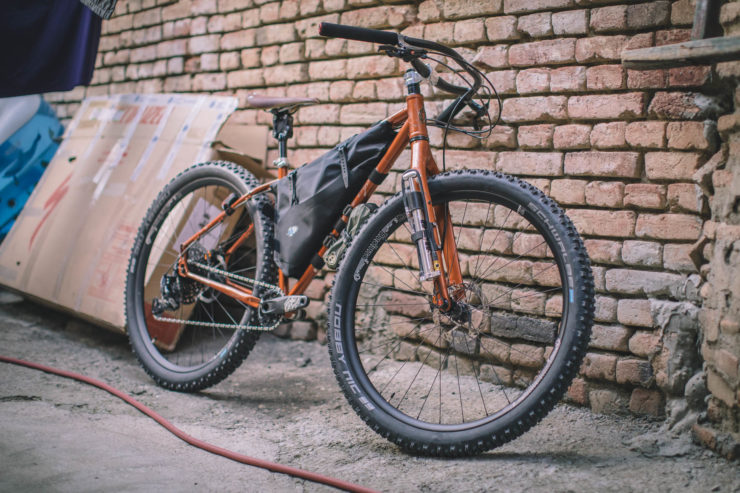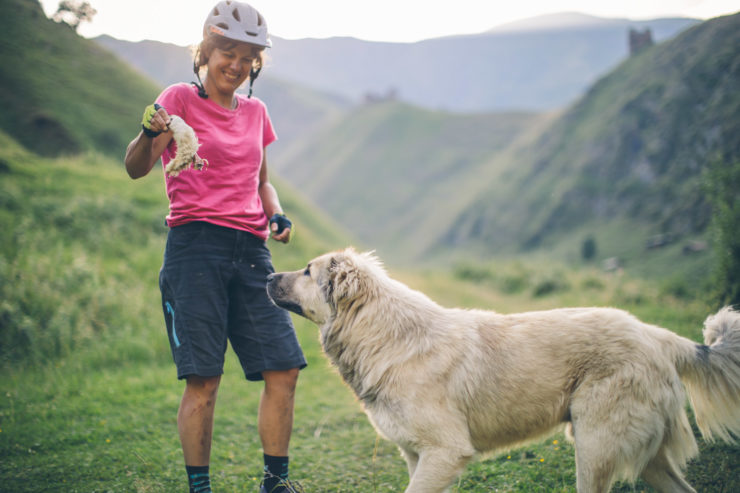VA’s Salsa Deadwood (Take 2): Built for Comfort
Share This
The second coming of Virginia’s Salsa Deadwood was a last-minute scramble build finished the day before our flight to the Republic of Georgia. Fortunately, it couldn’t have turned out any better… or more comfortably. In this Rider and Rig we talk to Virginia about her style of bikepacking and how to stay comfortable on long tours… plus her full packlist.
Back in 2012, after a multi-month blur of placing tenants in our house, selling many of our earthly possessions, putting the rest in storage, and planning a big bike trip, Virginia Krabill and I boxed a pair of Surly Trolls bound for Panama via Mexico and Central America. Prior to putting rubber to la carretera we only made time for one trial-run overnighter trip on those bikes. That was mistake number one. Fortunately, my bike fit like a glove. Gin wasn’t so lucky. Nevertheless she powered through many long days in the saddle.
Over the next two years we honed our kits and tweaked her blue Troll (AKA ‘Steve’) numerous times. We swapped out stems, saddles, and handlebars. She was even professionally fit for the bike, all to no avail. Since then she’s tried a few bikes… some that fit her well, and others that haven’t. In 2015 while scouting the Trans-Uganda bikepacking route, she rode the then new drop-bar Salsa Deadwood 29+. Although the fit was good, something was still a little “off”.
For our trip to the Republic of Georgia she decided to give the Deadwood a makeover, one that included a quick engagement I9 hub, 29 x 2.6″ ‘wide trail’ tires, a super short Paul Boxcar stem, Jones Loop handlebars, and a new saddle. As is our tendency, we made all of these changes at the last minute, leaving just enough time for a quick neighborhood test ride. After five years of trial and error did she finally figure out her perfect dirt-touring rig? I asked Gin a few questions to try and figure it out…

For starters, what’s your favorite type of riding conditions while bikepacking?
I like variety. A perfect scenario would be a combination of rolling hills interspersed with some tough climbs followed by long descents… all on dirt roads punctuated with small villages. I enjoy a combination of double and single track and don’t mind some pavement here and there. On extended journeys, or when the environs are getting a little mundane, paved roads change the pace up a bit, and, for me, it’s just fun to haul ass on occasion. Taking the time to explore more off the beaten path tracks can also be rewarding. Sometimes you find the sweetest trails and most interesting situations, and sometimes the consequences lead you to a seemingly dead-end. Even so, those challenges force you to be creative, and that’s a big part of the adventure..

What’s the most comfortable bike you’ve taken bikepacking… and least comfortable?
The most comfortable bike I’ve ever ridden while bikepacking is probably the Jamis Dragonslayer, but that’s owed in part to it having a suspension fork. When I’m bikepacking in my favorite places, it’s usually a safe bet to assume there won’t be any well equipped bike shops, and I’m no bike mechanic. As such, riding a fully rigid bike is the safest bet in places such as Uganda. But, I’ve struggled a lot over the years to find a comfortable ride on a rigid bike. I rode this bike — the Salsa Deadwood with Jones Bars – on a recent bikepacking trip, and I believe I’ve finally struck gold. The least comfortable bike for me was my old Surly Pugsley. It was just too heavy for me to manage on hike-a-bikes and even just while loading and unloading gear.
What do you think makes a bike uncomfortable?
Discomfort comes into play in a number of ways. While riding, the thing I’ve struggled with most over the years is my rear end. How much of that is actually due to the construction of the saddle versus my positioning on the bike is unclear. I’ve tried numerous saddles and I’ve adjusted their angles to no end. Another big issue I’ve had to contend with is my hands. They go numb, most noticeably, on gravel and paved roads, where there is just a constant, low-grade vibration. Again, I’ve tried stems of varying lengths, played with my saddle height, and numerous styles of handlebars and grips. On my most recent bikepacking venture, I tried out Jones Loop H-Bar, and I think they may well be the answer to that issue. All in all, finding the right fit can be an exhausting and frustrating matter of trial and error. Sometimes you just need to be open to making a drastic change and sometimes there are more nuanced adjustments that need to be made.
On a different note, the overall weight and size of a bike can really affect how comfortable it is. If a bike is cumbersome, or heavy, it’s no fun trying to load and unload your rig. If I can’t hold my bike up and handle the gear, it’s frustrating. If I can’t push it up a steep climb, it’s a no-go. Again, the current build on the Deadwood strikes a good balance. It has a relatively lightweight steel frame and a carbon fork… featherlight when compared to something like the Pugsley.
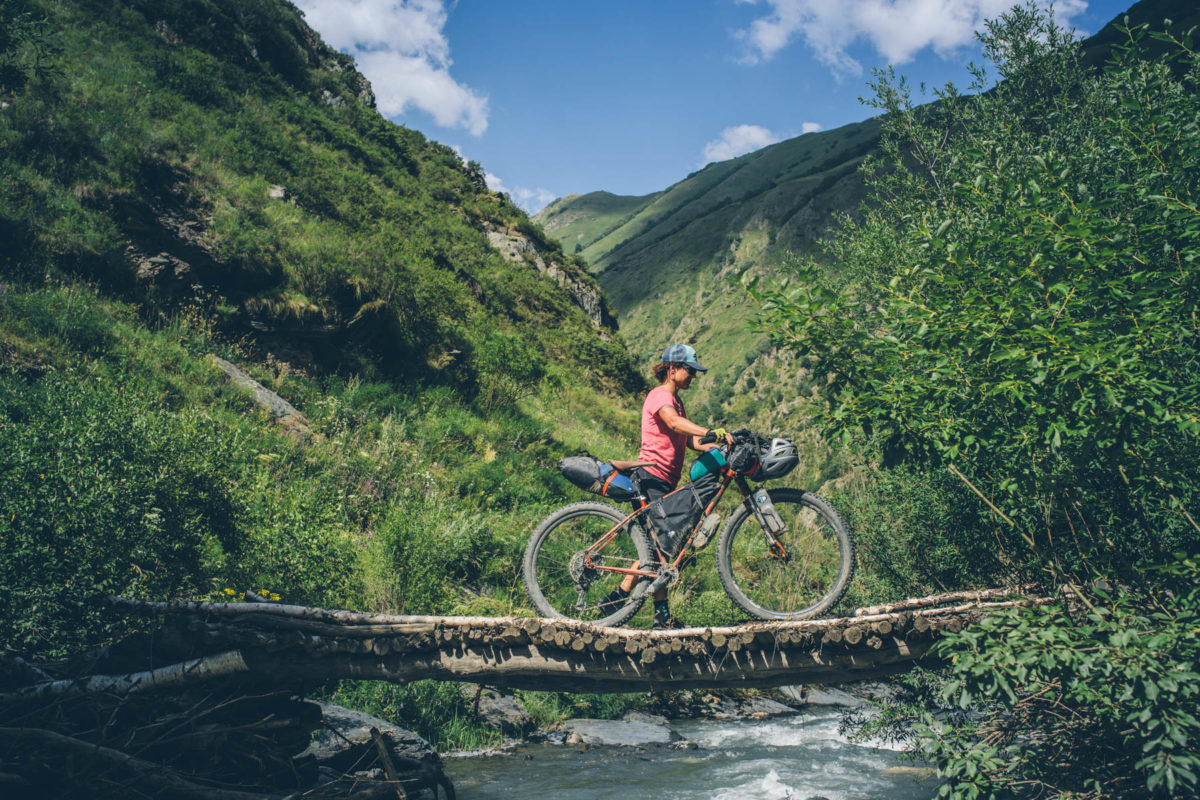
You’ve had a history of powering through discomfort on your long distance bikepacking rigs. What usually bothers you most?
The most frustrating thing about being uncomfortable on a long distance trip is accepting that I might just have to suck it up and deal with what I’ve got for the time being. You can only adjust positioning to the extent that your gear allows. And, unfortunately opportunities to swap components are sometimes limited. That may mean waiting a few days or even weeks to find a well-equipped bike shop with alternative saddles or stems, or it may just mean thinking about the changes you’ll make the next time you hit the road. I guess the best approach, given the opportunity, is to ride your bike a lot before setting out, so you can get it dialed in while you’ve got the chance.
What all have you tried in order to eliminate the discomfort?
I think I’ve tried just about everything. I’ve tried too many saddles to count, leather, plastic, softer, harder, narrow, wide. I’ve experimented with various styles of handlebars, grips, and seat posts. I’ve changed the length of my handlebar stem and added spacers to adjust their height. I’ve pushed my saddle as far back and forward as it will go. I’ve worn numerous bike shorts and chamois.

So the Brooks Cambium and Thudbuster combo have been a breakthrough as far as the rear end is concerned. Why?
If I could nail down exactly what it is I’d been missing all of these years, that would be great. In general, I’m rough on saddles, maybe I’m a little lazy in my riding style. I’ve just destroyed multiple leather saddles over the years, and it hasn’t taken long. As soon as they’re getting comfortable, they’re stretched to their limits. I met this girl (who’s name is escaping me right now) on our Swift campout. She swore by the Cambium C17, so I thought I’d give it a try. There’s just something about it that works. It was comfortable straight out of the box. I’ve tried a few (plastic) saddles that seemed comfortable at the onset, but quickly caused problems. This saddle has been consistent. As for the Thudbuster, I think it provides just enough dampening to alleviate some of the back strain and bum bruising that long days, riding over even minimal chatter, can create.
And the Jones Loop handlebars?
What I love most about these bars is the versatility. Repositioning my grip fairly frequently helps a lot with the numbness. It also helps with back strain, as I can stretch out when I need to or take a more upright stance when that feels right. I take the versatility that the handlebars’ shape provides a step farther than most people would. By rotating the handlebars in the stem, I can mix things up even more. It’s amazing how the smallest adjustments in their rotation can change the whole feel of the bike. I’ve tried drop bars, and though they’ve grown on me to some extent, they’re not nearly as comfortable or stable feeling as the Jones bars… especially more technical terrain. The foam grips are great too. I actually switched to foam grips on my trail bike as well. They provide a touch more vibration dampening, which I think helps with my nerve issues.
Theoretically, the shorter stem with the backswept bars kind of drop your elbows and shoulders, and give you a little more of an upright position. Do you think this has helped?
I haven’t really thought about the mechanics that much, but that makes sense. I do like an upright feel. And, by dropping the shoulders and elbows, it seems like there’s a lot less stress placed on my neck and shoulders, which is most likely the root of my nerve problems.
What do you think about the new 29×2.6” tires compared to the 3” tires you ran on the Deadwood in Africa?
I’m totally sold on the smaller tires. While the fatter tires may provide a little more cush on rough terrain, their heft is just too much for me. The 2.6”s are still big enough to absorb the bumps, but the smaller profile makes maneuverability much easier. They are simply a little more agile than the big 29×3 tires I had on the Deadwood in Uganda and Rwanda. Another plus… they don’t hold on to nearly as much mud.
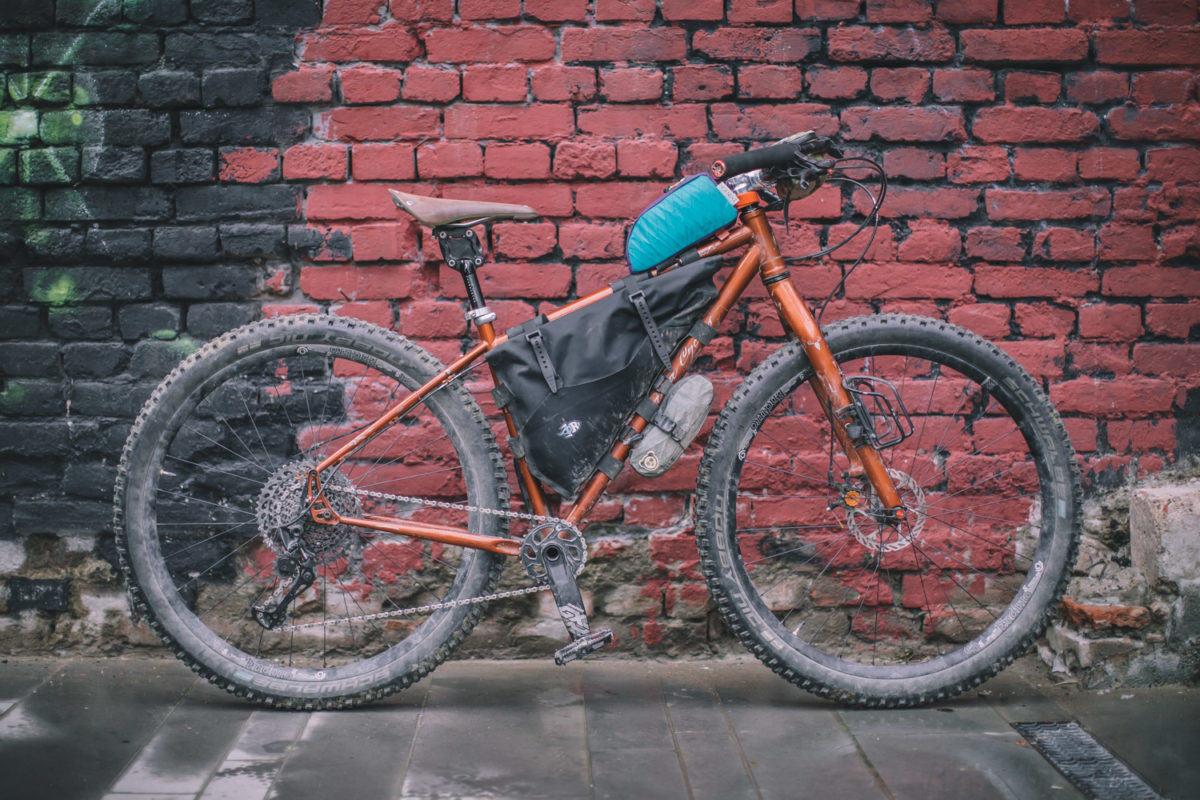
Bike Build
- Frame: Salsa Cycles Deadwood w/ 148x12mm rear dropout
- Fork: Salsa Firestarter (100x15mm thru-axle)
- Headset: Cane Creek 10
- Handlebar: Jones H-bar Loop
- Stem: Paul Components Boxcar
- Seatpost: Cane Creek Thudbuster
- Saddle: Brooks Cambium C17
- Grips: Jones EVA H-Grips
- Crank: SRAM Eagle GX 170mm
- Bottom Bracket: SRAM GX
- Chainring: 30t SRAM Eagle Narrow Wide Chainring
- Chain: SRAM Eagle GX
- Cassette: SRAM Eagle GX 10-50
- Shifter: SRAM Eagle GX
- Rear Derailleur: SRAM Eagle GX 12spd
- Brakes: Paul Components Klamper
- Brake Levers: Avid
- Rear Wheel: Industry Nine Torch Classic, Industry Nine Enduro 305
- Front Wheel: Industry Nine Torch Classic, Industry Nine Enduro 305
- Tires: Schwalbe Nobby Nic 29×2.6 Addix
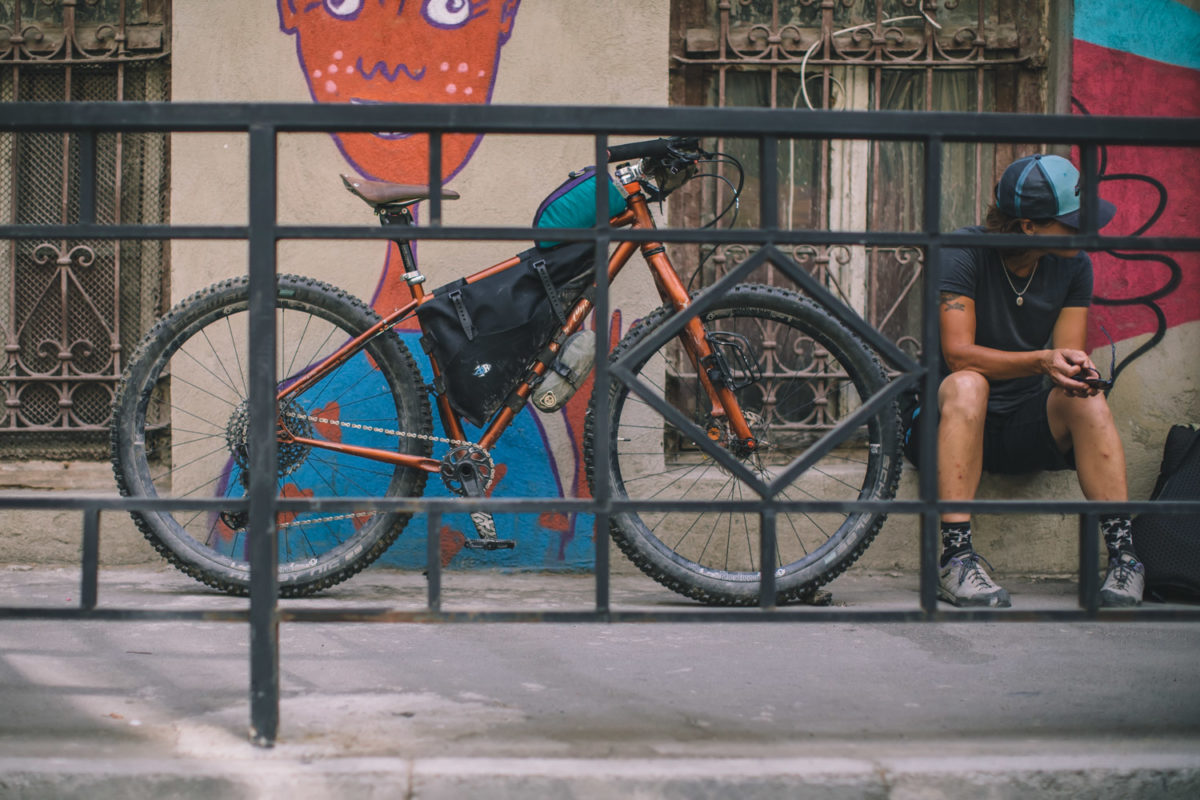
Bikepacking Bags & PACKLIST
Here is Virginia’s full packing list, by bag:
Handlebars (Revelate Sweetroll M)
Sleep system (Enlightened Equipment Revelation Quilt, Sea to Summit Ultralight Insulated Sleeping Mat… I’ve given up on a pillow), Big Agnes hooded pullover jacket, toiletries, tent poles
Handlebars (Revelate Periphery Pocket)
Phone, hat, paper map, Zip-locked passport, ink pen, snacks
Top Tube (Oveja Negra Snack Pack XL)
Battery charger and periphery cables, lip balm, titanium spork, snacks
Handlebars (Jones Loophole Pack)
More snacks, sunglasses, little nylon shopping bag/purse, riding gloves, Buff (actually a ½ Buff), sunscreen, 1-2 spare grocery/trash bags
Frame bag (Porcelain Rocket 52Hz)
This is where I like to keep my back-up supplies (eyeglasses, spare contact lenses, a few lady supplies), Lonely Planet Georgia, Armenia, and Azerbaijan paperback (I know, it’s crazy), Vargo 1.2L Ti cooking pot, Trangia stove, small Nalgene bottle of olive/canola oil blend, salt and pepper, 2 small bottles denatured alcohol, Fozzil (doubles as a plate, bowl and cutting board), Sawyer Mini water filter and bag, food
Seat Pack (Porcelain Rocket Mr. Fusion)
Clothes, including NZO riding shorts, 2 short sleeve merino t-shirts (Specialized and Icebreaker), Icebreaker wool skirt, Patagonia Merino Air hooded baselayer and bottoms, cotton leggings, 3 pairs of wool socks, 3 pairs of underwear, Outdoor Research Helium rain jacket
DOWNTUBE (Rogue Panda Oracle)
Spare tube, 8 oz Orange Seal sealant, tire lever, patch kit
What’s your favorite thing about bikepacking?
Exploring our wild public lands here in the US is great, but my true passion lies in using bikepacking as a means of international travel. For me, it’s all about the people you meet and the interpersonal experiences that you have. Being on a bicycle means you’re traveling slowly enough to actually interact with people… and the bicycle, no matter how fancy, is something that people can relate to. One of my favorite memories from our time in Malawi is when Logan and I were on a pretty boring stretch of flat backroad, and I rode up alongside a young woman on her bicycle. Without words, an unsolicited race ensued. As the miles went by, our exchanges became more and more playful. Genuine fun, smiles, and laughter between two people who may have never have enjoyed each other’s company were it not for our bikes. Bikepacking also allows us to get off the beaten path. We get to see places that we’d otherwise miss in a car, and still cover much more ground than we could on foot.
What was your favorite piece of gear on your last trip in the Republic of Georgia?
That’s a tough one. Since I’ve already lauded the Jones bars, Cambium saddle, and Thudbuster, I’d have to say that the combination of the Jones Loophole Pack and Revelate Periphery Pocket was pretty awesome. Between the two of them, I have more packing space than I needed for easy access items. And, in comparison to other front cockpit accessory bags I’ve used, I didn’t have to deal with the sag of an overloaded handlebar bag.
Another great piece of gear that I took to Georgia was the Enlightened Equipment Revalation quilt (rated 32°F/0°C). Call me old fashioned, but I’ve always been a bag gal. Quilts just looked a little fussy, having to strap them onto the sleeping pad, and I just couldn’t imagine that they could be as warm as a traditional sleeping bag. I was wrong. The minimal time it takes to strap the quilt to my sleeping pad is well made up for in the comfort it provides. It’s plenty warm when necessary, but it’s also easy to cool things down a little by loosening its straps. I also tend to toss and turn a bit in my sleep. With the quilt, I don’t get knotted up or feel stuck like I do in a bag. I wish I’d tried out a quilt earlier and saved myself a few restless nights.
For more on the Republic of Georgia, make sure to check out our Feature, The Breaking Trail. Also, to learn more about the route, read the Georgia’s Caucasus Crossing route guide.
FILED IN (CATEGORIES & TAGS)
Bikepacking Bikes
Worthy Builds
29-plus porcelain-rocket revelate-bags salsa-cyclesPlease keep the conversation civil, constructive, and inclusive, or your comment will be removed.













